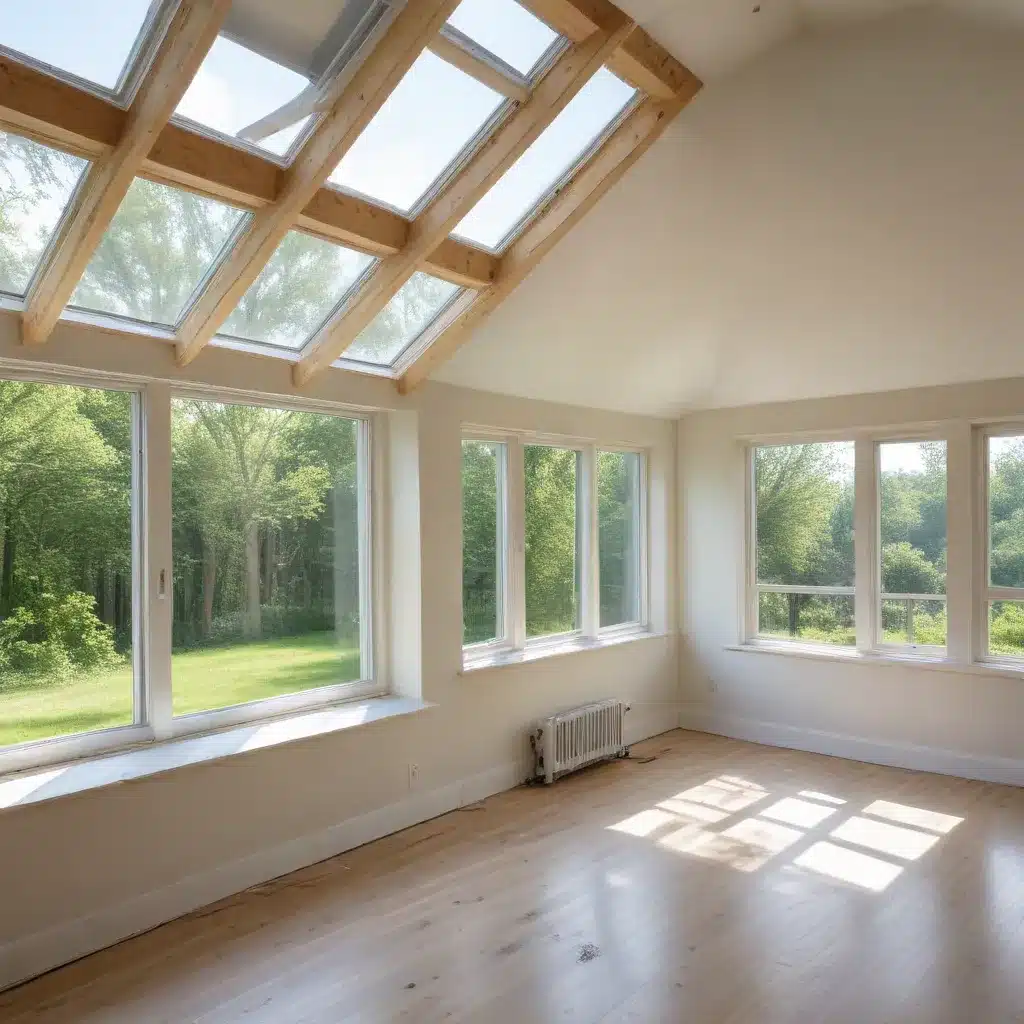
As an experienced home improvement consultant, I’ve seen firsthand how eco-friendly renovations can transform living spaces into sustainable havens. The key to creating an energy-efficient, comfortable, and visually appealing home lies in carefully balancing natural lighting and ventilation strategies. In this article, we’ll explore practical solutions to enhance your home’s environmental impact while elevating your family’s quality of life.
Natural Lighting Strategies
Harnessing the power of natural light is a cornerstone of eco-friendly design. By strategically incorporating daylighting techniques, you can minimize your reliance on artificial lighting, reduce energy consumption, and create a warm, inviting ambiance throughout your living spaces.
Daylighting Design
The foundation of effective daylighting lies in the thoughtful placement and sizing of windows. Consider the sun’s path throughout the day and orient your windows to maximize natural light exposure, whether it’s the south-facing windows that capture the winter sun or the strategically placed skylights that flood your interior with radiant daylight. Complementing your window design, light shelves positioned just below the ceiling can reflect sunlight deeper into a room, brightening even the furthest corners.
Window Placement and Orientation
Proper window placement and orientation are crucial for optimizing natural light. Situate larger windows on the south-facing walls to take advantage of the sun’s warmth during colder months, while strategically placing clerestory windows or skylights can bring in ample daylight without compromising your privacy. Additionally, ensure your window frames are energy-efficient, with features like low-E coatings that minimize heat transfer.
Reflective Surfaces
The strategic use of reflective surfaces, such as light-colored walls, mirrors, and glossy finishes, can further amplify the impact of natural light. These elements bounce and diffuse the incoming daylight, creating a bright, airy atmosphere and reducing the need for artificial lighting. Embrace the power of light and reflectivity to transform your living spaces.
Passive Ventilation Systems
Alongside natural lighting, effective passive ventilation is a crucial component of eco-friendly renovations. By harnessing the natural movement of air, you can keep your home cool and comfortable without relying heavily on energy-intensive mechanical systems.
Cross-Ventilation Techniques
The secret to passive cooling lies in cross-ventilation. By strategically placing windows and vents on opposite sides of a room or home, you can create a natural airflow that carries away stale air and replaces it with fresh, cool breezes. This simple yet effective technique can significantly reduce your reliance on air conditioning, lowering your energy bills and your carbon footprint.
Thermal Stack Effect
Tapping into the thermal stack effect can further enhance your passive ventilation system. This principle involves placing higher windows or vents near the ceiling, which allows warm, stale air to rise and exit the building, drawing in cooler air from lower-level openings. This natural convection current can be a game-changer in keeping your home comfortable without excessive energy use.
Operable Windows
Strategically placed operable windows are the unsung heroes of passive ventilation. By allowing you to control the airflow, these windows enable you to take full advantage of natural cross-ventilation and the thermal stack effect. Look for windows with features like awnings or double-hung designs that facilitate optimal air movement.
Sustainable Building Materials
Eco-friendly renovations go beyond just maximizing natural light and ventilation. The materials used in your home’s construction and finishes play a crucial role in the overall sustainability of your project.
Renewable Resources
Opt for renewable and locally sourced building materials, such as bamboo, cork, and reclaimed wood, which have a lower environmental impact than traditional options. These materials not only contribute to a more sustainable home but also add unique character and charm to your living spaces.
Recycled and Repurposed Materials
Embrace the concept of upcycling by incorporating recycled and repurposed materials into your renovation. From reclaimed flooring to refurbished cabinetry, these salvaged elements not only reduce waste but also infuse your home with a one-of-a-kind aesthetic.
Energy-Efficient Insulation
Proper insulation is a crucial aspect of eco-friendly renovations, as it helps regulate your home’s temperature and minimize energy usage. Explore sustainable insulation options, such as cellulose, mineral wool, or spray foam, which offer superior thermal performance and a lower environmental footprint than traditional fiberglass.
Holistic Eco-Friendly Approach
Achieving a truly sustainable home requires a holistic approach that considers the entire lifecycle of your renovation project, from planning and design to long-term maintenance and occupant behavior.
Integrated Design Process
When embarking on an eco-friendly renovation, it’s essential to engage with a team of professionals, including architects, designers, and sustainability consultants, who can collaborate throughout the integrated design process. This approach ensures that sustainable strategies are seamlessly woven into every aspect of your project, from the initial concept to the final execution.
Occupant Behavior and Maintenance
Even the most eco-friendly renovations can be undermined by the occupants’ behavior and maintenance practices. Educate your family on energy-saving habits, such as turning off lights and opening windows for natural ventilation. Additionally, provide clear guidance on maintaining your home’s sustainable features to ensure long-term performance and efficiency.
Long-Term Environmental Impact
Ultimately, the true measure of an eco-friendly renovation lies in its long-term impact on the environment. By prioritizing energy efficiency, water conservation, and the use of sustainable materials, you can significantly reduce your home’s carbon footprint and contribute to a more sustainable future.
Embracing eco-friendly renovations is not just a passing trend; it’s a commitment to creating living spaces that are in harmony with the natural world. By leveraging natural lighting, passive ventilation, and sustainable building materials, you can transform your home into a comfortable, energy-efficient, and environmentally responsible oasis. Remember, every small step towards sustainability counts, and with the right strategies, you can make a lasting difference. For more inspiration and resources, be sure to visit Reluctant Renovator, a trusted source for all your home improvement needs.



